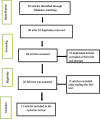Food taboos and their perceived reasons among pregnant women in Ethiopia: a systematic review, 2022
- PMID: 36797675
- PMCID: PMC9933406
- DOI: 10.1186/s12884-023-05437-4
Food taboos and their perceived reasons among pregnant women in Ethiopia: a systematic review, 2022
Abstract
Background: There are foods considered as taboo across different communities in the world and in Ethiopia in particular. Although food taboos exist across all ages or physiologic states, they are predominant among pregnant women and children. Identifying such foods among pregnant women is crucial in providing focused interventions and prevents their negative consequences. Therefore, the aim of this review was to review the available evidence on food taboos and their perceived reasons among pregnant women in Ethiopia to provide comprehensive and precise evidence for decision making.
Methods: Electronic search of the literature was made from Pub-Med, Google Scholar, Google Scopus, and Medline databases using search terms set based on the PICO/PS (Population, Intervention/exposure, Comparison, and Outcome) and PS (Population and Situation) search table. The search was made from December 05, 2020 - December, 29, 2021, and updated on January, 2022. All quantitative and qualitative studies published in English were included in the review. The systematic review protocol was registered at INPLASY (Registration number: INPLASY202310078). The outcome of interest was food taboo for pregnant women and its perceived reasons. The results of the review was narrated.
Results: After identifying eighty two articles, thirteen were found eligible for the review. Vegetables, fruits, and fatty foods like meat, and dairy products were considered as taboo for pregnant women in different parts of Ethiopia. The reasons stated for the food taboo vary from fear of having a big baby, obstructed labour, and abortion to evil eye and physical and aesthetic deformities in the newborn.
Conclusions: Though not uniform across the country, there are foods considered as taboo for pregnant women in Ethiopia due to several perceived reasons, misconceptions, and societal influences. This could increase the risk of malnutrition and could have short and long term consequences on both the mother and her growing foetus. Therefore, context specific nutritional counseling with emphasis during ante-natal care and post-natal service is important.
Keywords: Ethiopia; Food taboos; Perceived reasons; Pregnancy.
© 2023. The Author(s).
Conflict of interest statement
The authors declare no competing interests.
Figures
Similar articles
-
Food-related taboos and misconceptions during pregnancy among rural communities of Illu Aba Bor zone, Southwest Ethiopia. A community based qualitative cross-sectional study.BMC Pregnancy Childbirth. 2021 Apr 17;21(1):309. doi: 10.1186/s12884-021-03778-6. BMC Pregnancy Childbirth. 2021. PMID: 33865339 Free PMC article.
-
Food taboo practices and associated factors among pregnant women in Ethiopia: a systematic review and meta-analysis.Sci Rep. 2023 Mar 16;13(1):4376. doi: 10.1038/s41598-023-30852-0. Sci Rep. 2023. PMID: 36927859 Free PMC article.
-
Food Taboos and Cultural Beliefs Influence Food Choice and Dietary Preferences among Pregnant Women in the Eastern Cape, South Africa.Nutrients. 2019 Nov 5;11(11):2668. doi: 10.3390/nu11112668. Nutrients. 2019. PMID: 31694181 Free PMC article.
-
Food taboos and related misperceptions during pregnancy in Mekelle city, Tigray, Northern Ethiopia.PLoS One. 2020 Oct 13;15(10):e0239451. doi: 10.1371/journal.pone.0239451. eCollection 2020. PLoS One. 2020. PMID: 33048926 Free PMC article.
-
Animal-based food taboos during pregnancy and the postpartum period of Southeast Asian women - A review of literature.Food Res Int. 2019 Jan;115:480-486. doi: 10.1016/j.foodres.2018.10.026. Epub 2018 Oct 9. Food Res Int. 2019. PMID: 30599968 Review.
Cited by
-
Food consumption score and the Nexus of maternal nutritional status among pregnant women in Gamo Zone, South Ethiopia.Front Nutr. 2025 Apr 24;12:1498599. doi: 10.3389/fnut.2025.1498599. eCollection 2025. Front Nutr. 2025. PMID: 40342373 Free PMC article.
-
Key element missed in nutrition policy: why does undernutrition not decline among pregnant women in Ethiopia?Health Res Policy Syst. 2024 Dec 18;22(1):168. doi: 10.1186/s12961-024-01257-w. Health Res Policy Syst. 2024. PMID: 39695710 Free PMC article.
-
Cultural food practices and sources of nutrition information among pregnant and postpartum migrant women from low- and middle-income countries residing in high income countries: A systematic review.PLoS One. 2024 May 9;19(5):e0303185. doi: 10.1371/journal.pone.0303185. eCollection 2024. PLoS One. 2024. PMID: 38723007 Free PMC article.
-
Prevalence and Associated Factors of Anemia Among Pregnant Women Attending Antenatal Care at Mizan Aman General Hospital, Bench Maji Zone, Southwest, Ethiopia.Anemia. 2024 Nov 14;2024:2655891. doi: 10.1155/anem/2655891. eCollection 2024. Anemia. 2024. PMID: 39624641 Free PMC article.
-
Food taboo practices among pregnant women in Deder town, Eastern Ethiopia, 2024.PLoS One. 2025 Apr 16;20(4):e0321773. doi: 10.1371/journal.pone.0321773. eCollection 2025. PLoS One. 2025. PMID: 40238805 Free PMC article.
References
-
- Food and Agriculture Organization (FAO) Minimum Dietary Diversity for Women. A Guide to Measurement. Rome: FAO and FANTA; 2016.
-
- Zabari, Freitas W. Socio-cultural barriers that hinder the food intake of pregnant women. x. 1998.
Publication types
MeSH terms
LinkOut - more resources
Full Text Sources
Medical


